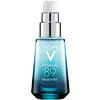What's inside
What's inside
 Key Ingredients
Key Ingredients

 Benefits
Benefits

 Concerns
Concerns

 Ingredients Side-by-side
Ingredients Side-by-side

Water
Skin ConditioningGlycerin
HumectantPropanediol
SolventNiacinamide
SmoothingButylene Glycol
HumectantDiglycerin
HumectantPolyglycerin-3
HumectantBoron Nitride
AbsorbentAframomum Angustifolium Seed Extract
Skin ConditioningPaeonia Lactiflora Root Extract
Skin ConditioningLilium Candidum Bulb Extract
Skin ConditioningJasminum Officinale Flower Extract
MaskingAvena Sativa Kernel Extract
AbrasiveSaccharomyces Cerevisiae Extract
Skin ConditioningSecale Cereale Seed Extract
AbrasiveAscorbyl Glucoside
AntioxidantAdenosine
Skin ConditioningSodium Tocopheryl Phosphate
AntioxidantPalmaria Palmata Extract
Skin ProtectingHydrolyzed Soy Protein
HumectantAlcohol
AntimicrobialXylitol
HumectantChlorphenesin
AntimicrobialParfum
MaskingHydroxyacetophenone
AntioxidantCI 77891
Cosmetic ColorantSodium Hydroxide
BufferingSodium Surfactin
CleansingPyrus Cydonia Seed Extract
MaskingSodium Benzoate
MaskingBiosaccharide Gum-2
Skin Conditioning1,2-Hexanediol
Skin ConditioningSodium Acetylated Hyaluronate
HumectantSodium Metabisulfite
AntioxidantPotassium Sorbate
PreservativeTrehalose
HumectantPentylene Glycol
Skin ConditioningCarbomer
Emulsion StabilisingAcrylates/C10-30 Alkyl Acrylate Crosspolymer
Emulsion StabilisingMica
Cosmetic ColorantCaprylyl Glycol
EmollientWater, Glycerin, Propanediol, Niacinamide, Butylene Glycol, Diglycerin, Polyglycerin-3, Boron Nitride, Aframomum Angustifolium Seed Extract, Paeonia Lactiflora Root Extract, Lilium Candidum Bulb Extract, Jasminum Officinale Flower Extract, Avena Sativa Kernel Extract, Saccharomyces Cerevisiae Extract, Secale Cereale Seed Extract, Ascorbyl Glucoside, Adenosine, Sodium Tocopheryl Phosphate, Palmaria Palmata Extract, Hydrolyzed Soy Protein, Alcohol, Xylitol, Chlorphenesin, Parfum, Hydroxyacetophenone, CI 77891, Sodium Hydroxide, Sodium Surfactin, Pyrus Cydonia Seed Extract, Sodium Benzoate, Biosaccharide Gum-2, 1,2-Hexanediol, Sodium Acetylated Hyaluronate, Sodium Metabisulfite, Potassium Sorbate, Trehalose, Pentylene Glycol, Carbomer, Acrylates/C10-30 Alkyl Acrylate Crosspolymer, Mica, Caprylyl Glycol
 Reviews
Reviews

Ingredients Explained
These ingredients are found in both products.
Ingredients higher up in an ingredient list are typically present in a larger amount.
Adenosine is in every living organism. It is one of four components in nucleic acids that helps store our DNA.
Adenosine has many benefits when used. These benefits include hydrating the skin, smoothing skin, and reducing wrinkles. Once applied, adenosine increases collagen production. It also helps with improving firmness and tissue repair.
Studies have found adenosine may also help with wound healing.
In skincare products, Adenosine is usually derived from yeast.
Learn more about AdenosineCaprylyl Glycol is a humectant and emollient, meaning it attracts and preserves moisture.
It is a common ingredient in many products, especially those designed to hydrate skin. The primary benefits are retaining moisture, skin softening, and promoting a healthy skin barrier.
Though Caprylyl Glycol is an alcohol derived from fatty acids, it is not the kind that can dry out skin.
This ingredient is also used as a preservative to extend the life of products. It has slight antimicrobial properties.
Learn more about Caprylyl GlycolCarbomer is a polymer of acrylic acid. Its main role is to create a gel consistency.
A high amount of carbomer can cause pilling or balling up of products. Don't worry, most products contain 1% or less of carbomer.
Glycerin is already naturally found in your skin. It helps moisturize and protect your skin.
A study from 2016 found glycerin to be more effective as a humectant than AHAs and hyaluronic acid.
As a humectant, it helps the skin stay hydrated by pulling moisture to your skin. The low molecular weight of glycerin allows it to pull moisture into the deeper layers of your skin.
Hydrated skin improves your skin barrier; Your skin barrier helps protect against irritants and bacteria.
Glycerin has also been found to have antimicrobial and antiviral properties. Due to these properties, glycerin is often used in wound and burn treatments.
In cosmetics, glycerin is usually derived from plants such as soybean or palm. However, it can also be sourced from animals, such as tallow or animal fat.
This ingredient is organic, colorless, odorless, and non-toxic.
Glycerin is the name for this ingredient in American English. British English uses Glycerol/Glycerine.
Learn more about GlycerinPropanediol is an all-star ingredient. It softens, hydrates, and smooths the skin.
It’s often used to:
Propanediol is not likely to cause sensitivity and considered safe to use. It is derived from corn or petroleum with a clear color and no scent.
Learn more about PropanediolWater. It's the most common cosmetic ingredient of all. You'll usually see it at the top of ingredient lists, meaning that it makes up the largest part of the product.
So why is it so popular? Water most often acts as a solvent - this means that it helps dissolve other ingredients into the formulation.
You'll also recognize water as that liquid we all need to stay alive. If you see this, drink a glass of water. Stay hydrated!
Learn more about Water